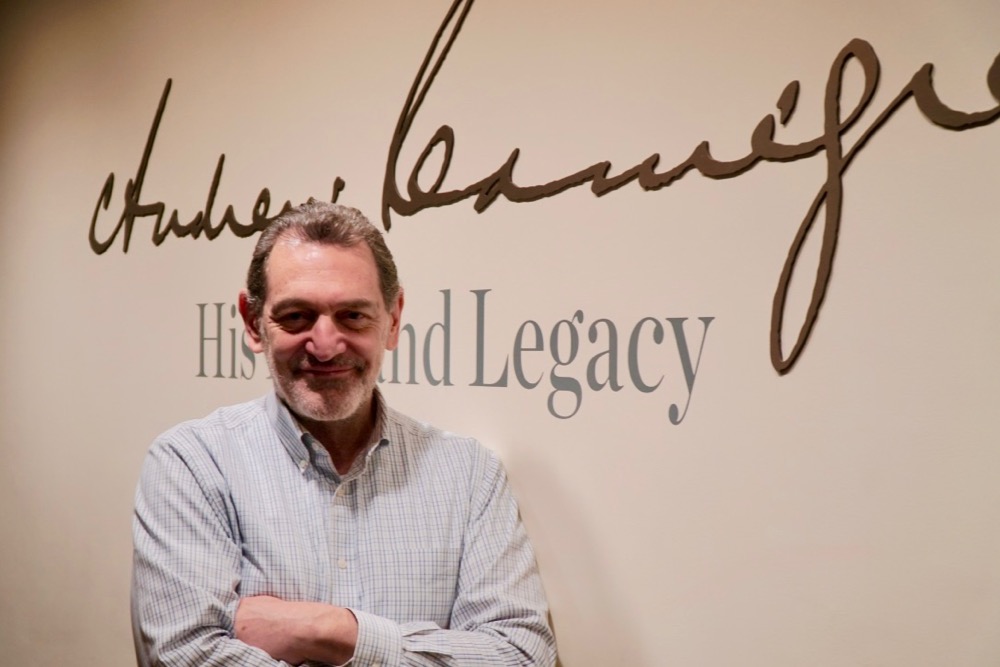At Carnegie Hall – Migrations – the Making of America
When in New York recently I met up with Gino Francesconi who is the Director of Archives at Carnegie Hall. Of Italian descent himself he knows all about people who came to America from elsewhere. His research into Andrew Carnegie has this year resulted in a fascinating display about the philanthropist which you can see for free if you get a ticket for a concert there.
We may know Andrew Carnegie as the wealthy man who has spread his Let There Be Light motto by funding public libraries. He began his love of reading by trying to access Colonel James Anderson’s private library of 400 books but was told that as a bobbin boy earning only $1.20 a week, he was ‘not respectable enough’. After writing a letter to the Pittsburgh Dispatch at age 14 he persuaded the Colonel to open his library to all boys. One of the first books he read was The Magic of Kindness and the book is on display in the Rose Museum.

He later moved on to work with the telegraph company memorising Morse Code by sound and interpreting messages by ear. This job meant he doubled his salary.
There are photos of Carnegie, his younger brother Tom, the manifest from the passenger of the Wiscasset in 1848 showing the names of all four members of the family travelling across the Atlantic in search of a new life.
In the exhibition you can see for yourself more about him. It is unusual for Carnegie Hall to concentrate on the man, rather than what goes on in the fabulous surroundings of the venue.
This is the story of a man who made lots of money but whose life was not untouched by tragedy, losing his younger brother at a relatively young age in the same year as his mother.
I asked Mr Francesconi about the reason for that and he told me: “Normally our permanent exhibition consists of performance history and the building history of the hall itself. People can usually see more than 300 items related to the hall including items like Benny Goodman’s clarinet. But this year is the centenary of Andrew Carnegie’s death we decided to do a temporary exhibition on the man himself. It’s the first time we’ve ever done this. It was a little intimidating as it is an enormous story, but when I started writing I thought we could fit it all in.”
Carnegie and his parents and brother emigrated from Dunfermline, taking a long ten weeks to get to Pittsburgh where his two maternal aunts already lived.
Some of the items have been borrowed from the Andrew Carnegie Birthplace Museum in Dunfermline.

The benefactor’s Edinburgh-born great grandson William Thomson loaned the 1887 pre-nuptial agreement which Andrew Carnegie and his wife, Louise. By the time Carnegie married he had already decided that a large proportion of his wealth had to be given away and he wanted Louise to help him do that.

Gino confessed that even after going through 30,000 pages of Carnegie’s papers at the Library of Congress the man remained an enigma. He explained : “He was so smart and so affable and considered himself enlightened. He wrote books on anti-slavery and socialism. When he wasn’t writing he was reading. I think he was a consummate workaholic.”
By the time Carnegie was in his thirties he was already semi-retired as he had made so much of his wealth. One of his first investments was $500 in the Adams Express Company which went on to become American Express. In 1889 he published a book called Wealth urging others in his position to distribute their money to others rather than living lavish lifestyles.
Carnegie enjoyed going to the Hall which was opened in 1891 with a week-long festival. At that time the Hall was two and a half miles north of the city centre and the subway had not yet been constructed.
Now it is a venue which has a huge variety of events. It is a hall where shows are put on for one night only. Their archives document over 50,000 events.
Alongside the free exhibition in the Rose Museum running till 31 October 2019, is the Migrations Festival focussing on Irish-Scottish migration, the Eastern European and African American migrations. This began on 9 March 2019 and continues until the end of May.
The story of music and its legacy connected with these various migrations is being told in the hall and other venues in New York. The full listing is here.
Sadly you have missed Edinburgh’s Karine Polwart who already performed there last month and you can listen to the podcast with Thistle and Shamrock she made then here :
Saturday, March 9, 2019—Thursday, October 31, 2019
Andrew Carnegie: His Life and Legacy
Rose Museum at Carnegie Hall
154 West 57th Street | Manhattan
carnegiehall.org
In Carnegie Hall’s first exhibit about its founder, Andrew Carnegie, Archives and Rose Museum Director Gino Francesconi charts the Carnegie family’s passage from Scotland and Andrew’s ever-present influence in America.
FREE
Open seven days a week, 11:00 a.m.–4:30 p.m.
(Also available evenings to Stern Auditorium / Perelman Stage concert patrons)